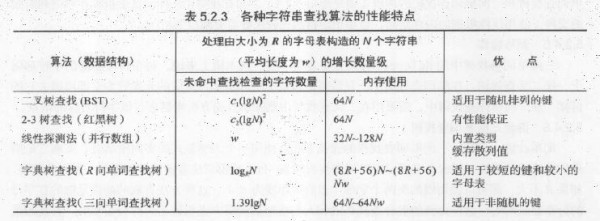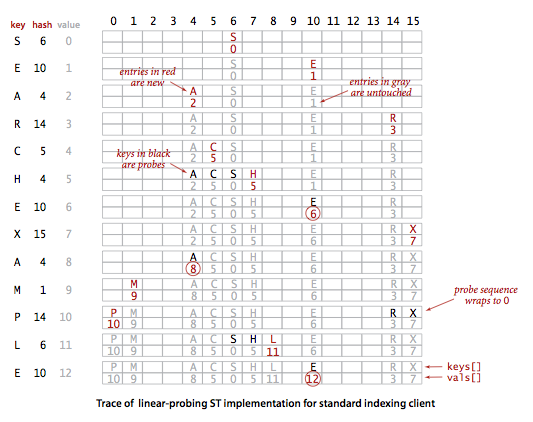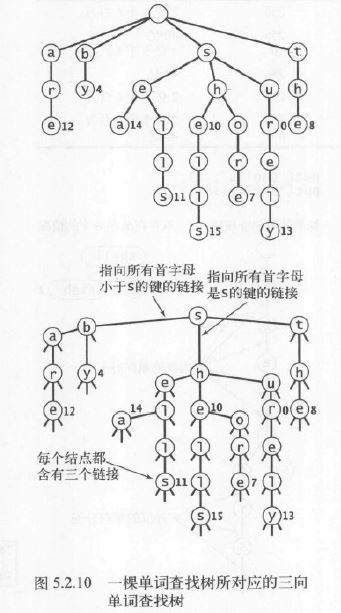首先,來看1張各種字符串查找算法的匯總。前面的文章已介紹過2叉樹查找和紅黑樹查找。這里不在介紹。
本文重點(diǎn)介紹后面3種查找算法:線性探測法、R向單詞查找樹和3向單詞查找樹。

實(shí)現(xiàn)散列表的另外一種方式是用大小為M的數(shù)組保存N個(gè)鍵值對(duì),其中M>N。依托數(shù)據(jù)中的空位解決碰撞沖突。基于這類策略的所有方法都統(tǒng)稱為開放地址散列表。其中最簡單的方法叫做線性探測法:當(dāng)碰撞產(chǎn)生時(shí),直接檢查散列表的下1個(gè)位置(索引加1),可能產(chǎn)生3種結(jié)果:
其核心思想是與其將內(nèi)存用作鏈表,不如將它們作為散列表的空元素。即用散列函數(shù)找到索引,檢查其中的鍵和被查找的鍵是不是相同。如果不同則繼續(xù)查找(增加索引,到達(dá)數(shù)組結(jié)尾后再折回?cái)?shù)組開頭),直到找到該鍵或遇到1個(gè)空元素。進(jìn)程以下圖所示:

在基于線性探測法的散列表中履行刪除操作比較復(fù)雜,如果將該鍵所在位置為為null是不行的。需要將簇中被刪除鍵的右邊的所有鍵重新插入散列表。
代碼實(shí)現(xiàn):
//基于線性探測的符號(hào)表
public class LinearProbingHashST<Key,Value>
{
private static final int INIT_CAPACITY = 16;
private int n;// 鍵值對(duì)數(shù)量
private int m;// 散列表的大小
private Key[] keys;// 保存鍵的數(shù)組
private Value[] vals;// 保存值的數(shù)組
public LinearProbingHashST()
{
this(INIT_CAPACITY);
}
@SuppressWarnings("unchecked")
public LinearProbingHashST(int capacity)
{
this.m = capacity;
keys = (Key[]) new Object[capacity];
vals = (Value[]) new Object[capacity];
}
public int hash(Key key)
{
return (key.hashCode() & 0x7fffffff) % m;
}
public void put(Key key, Value val)
{
if(key == null)
{
throw new NullPointerException("key is null");
}
if(val == null)
{
delete(key);
return;
}
// TODO擴(kuò)容
if(n >= m/2)
{
resize(2*m);
}
int i = hash(key);
for (; keys[i] != null; i = (i + 1) % m)
{
if(key.equals(keys[i]))
{
vals[i] = val;
return;
}
}
keys[i] = key;
vals[i] = val;
n++;
}
public void delete(Key key)
{
if(key == null)
{
throw new NullPointerException("key is null");
}
if (!contains(key))
{
return;
}
// 找到刪除的位置
int i = hash(key);
while (!key.equals(keys[i]))
{
i = (i + 1) % m;
}
keys[i] = null;
vals[i] = null;
// 將刪除位置后面的值重新散列
i = (i + 1) % m;
for (; keys[i] != null; i = (i + 1) % m)
{
Key keyToRehash = keys[i];
Value valToRehash = vals[i];
keys[i] = null;
vals[i] = null;
n--;
put(keyToRehash, valToRehash);
}
n--;
// TODO縮容
if(n>0 && n == m/8)
{
resize(m/2);
}
}
public Value get(Key key)
{
if(key == null)
{
throw new NullPointerException("key is null");
}
for (int i = hash(key); keys[i] != null; i = (i + 1) % m)
{
if(key.equals(keys[i]))
{
return vals[i];
}
}
return null;
}
public boolean contains(Key key)
{
if(key == null)
{
throw new NullPointerException("key is null");
}
return get(key) != null;
}
private void resize(int cap)
{
LinearProbingHashST<Key,Value> t;
t = new LinearProbingHashST<Key,Value>(cap);
for(int i = 0; i < m; i++)
{
if(keys[i] != null)
{
t.put(keys[i], vals[i]);
}
}
keys = t.keys;
vals = t.vals;
m = t.m;
}
public static void main(String[] args)
{
LinearProbingHashST<String, String> st = new LinearProbingHashST<String, String>();
String[] data = new String[]{"a", "b", "c", "d", "e", "f", "g", "h", "m"};
String[] val = new String[]{"aaa", "bbb", "ccc", "ddd", "eee", "fff", "ggg", "hhh", "mmm"};
for (int i = 0; i < data.length; i++)
{
st.put(data[i], val[i]);
}
for (int i = 0; i < data.length; i++)
{
System.out.println(data[i] + " " + st.get(data[i]));
}
}
}3.1 定義
與各種查找樹1樣,單詞查找樹也是由鏈接的結(jié)點(diǎn)所組成的數(shù)據(jù)結(jié)構(gòu)。每一個(gè)結(jié)點(diǎn)只有1個(gè)父結(jié)點(diǎn)(根結(jié)點(diǎn)除外),每一個(gè)結(jié)點(diǎn)都含有R條鏈接,其中R為字母表的大小。每一個(gè)鍵所關(guān)聯(lián)的值保存在該鍵的最后1個(gè)字母所對(duì)應(yīng)的結(jié)點(diǎn)中。值為空的結(jié)點(diǎn)在符號(hào)表中沒有對(duì)應(yīng)的鍵,它們的存在是為了簡化單詞查找樹中的查找操作。

3.2 查找操作
單詞查找樹的查找操作非常簡單,從首字母開始延著樹結(jié)點(diǎn)查找就能夠:
3.3 插入操作
和2叉查找樹1樣,在插入之前要進(jìn)行1次查找。
在到達(dá)鍵的尾字符之前就遇到了1個(gè)空鏈接。證明不存在匹配的結(jié)點(diǎn),為鍵中還未被檢查的每一個(gè)字符創(chuàng)建1個(gè)對(duì)應(yīng)的結(jié)點(diǎn),并將鍵對(duì)應(yīng)的值保存到最后1個(gè)字符的結(jié)點(diǎn)中。
在遇到空鏈接之前就到達(dá)了鍵的尾字符。將該結(jié)點(diǎn)的值設(shè)為鍵對(duì)應(yīng)的值(不管該值是不是為空)。
3.4 刪除操作
刪除的第1步是找到鍵所對(duì)應(yīng)的結(jié)點(diǎn)并將它的值設(shè)為空null. 如果該結(jié)點(diǎn)含有1個(gè)非空的鏈接指向某個(gè)子結(jié)點(diǎn),那末就不需要再進(jìn)行其他操作了。如果它的所有鏈接均為空,那就需要從數(shù)據(jù)結(jié)構(gòu)中刪除這個(gè)結(jié)點(diǎn)。如果刪除它使得它的父結(jié)點(diǎn)的所有鏈接也均為空,就要繼續(xù)刪除它的父結(jié)點(diǎn),依此類推。
3.5 代碼實(shí)現(xiàn)
//基于R向單詞查找樹的符號(hào)表
public class TrieST<Value> {
private static int R = 256; //基數(shù)
private Node root;
private static class Node
{
private Object val;
private Node[] next = new Node[R];
}
@SuppressWarnings("unchecked")
public Value get(String key)
{
Node x = get(root, key, 0);
if(x == null)
{
return null;
}
return (Value)x.val;
}
private Node get(Node x, String key, int d)
{
//返回以x作為根結(jié)點(diǎn)的字單詞查找樹中與key相干聯(lián)的值
if(x == null)
{
return null;
}
if(d == key.length())
{
return x;
}
char c = key.charAt(d);//找到第d個(gè)字符所對(duì)應(yīng)的字單詞查找樹
return get(x.next[c], key, d + 1);
}
public void put(String key, Value val)
{
root = put(root, key, val, 0);
}
private Node put(Node x, String key, Value val, int d)
{
//如果key存在于以x為根結(jié)點(diǎn)的子單詞查找樹中則更新與它相干聯(lián)的值
if(x == null)
{
x = new Node();
}
if(d == key.length())
{
x.val = val;
return x;
}
char c = key.charAt(d);//找到第d個(gè)字符所對(duì)應(yīng)的字單詞查找樹
x.next[c] = put(x.next[c], key, val, d + 1);
return x;
}
public void delete(String key)
{
root = delete(root, key, 0);
}
private Node delete(Node x, String key, int d)
{
if(x == null)
{
return null;
}
if(d == key.length())
{
x.val = null;
}
else
{
char c= key.charAt(d);
x.next[c] = delete(x.next[c], key, d+1);
}
if(x.val != null)
{
return x;
}
for(char c = 0; c < R; c++)
{
if(x.next[c] != null)
{
return x;
}
}
return null;
}
public static void main(String[] args)
{
TrieST<Integer> newST = new TrieST<Integer>();
String[] keys= {"Nicholas", "Nate", "Jenny", "Penny", "Cynthina", "Michael"};
for(int i = 0; i < keys.length; i++)
{
newST.put(keys[i], i);
}
newST.delete("Penny");
for(int i = 0; i < keys.length; i++)
{
Object val = newST.get(keys[i]);
System.out.println(keys[i] + " " + val);
}
}
}4.1 定義
3向單詞查找樹可以免R向單詞查找樹過度的空間消耗。它的每一個(gè)結(jié)點(diǎn)都含有1個(gè)字符、3條鏈接和1個(gè)值。3條鏈接分別對(duì)應(yīng)當(dāng)前字母小于、等于和大于結(jié)點(diǎn)字母的所有鍵。

4.1 查找、插入和刪除操作
在查找時(shí),首先比較鍵的首字母和根結(jié)點(diǎn)的字母。如果鍵的首字母較小,就選擇左鏈接;如果較大,就選擇右鏈接;如果相等則選擇中鏈接。然后遞歸地使用相同的算法。如果遇到1個(gè)空鏈接或當(dāng)鍵結(jié)束時(shí)結(jié)點(diǎn)的值為空,那末查找未命中。如果鍵結(jié)束時(shí)結(jié)點(diǎn)的值非空則查找命中。
插入1個(gè)新鍵時(shí),首先進(jìn)行查找,然后和單詞查找樹1樣,在樹中補(bǔ)全鍵末尾的所有結(jié)點(diǎn)。
在3向單詞查找樹中,需要使用在2叉查找樹中刪除結(jié)點(diǎn)的方法來刪去與該字符對(duì)應(yīng)的結(jié)點(diǎn)。
4.3 代碼實(shí)現(xiàn)
//基于3向單詞查找樹的符號(hào)表
public class TST<Value> {
private Node root;
private class Node
{
char c;
Node left, mid, right;
Value val;
}
public Value get(String key)
{
Node x = get(root, key, 0);
if(x == null)
{
return null;
}
return x.val;
}
private Node get(Node x, String key, int d)
{
if(x == null)
{
return null;
}
char c = key.charAt(d);
if(c < x.c)
{
return get(x.left, key, d);
}
else if(c > x.c)
{
return get(x.right, key, d);
}
else if(d < key.length() - 1)
{
return get(x.mid, key, d + 1);
}
else
{
return x;
}
}
public void put(String key, Value val)
{
root = put(root, key, val, 0);
}
private Node put(Node x, String key, Value val, int d)
{
char c = key.charAt(d);
if(x == null)
{
x = new Node();
x.c = c;
}
if(c < x.c)
{
x.left = put(x.left, key, val, d);
}
else if(c > x.c)
{
x.right = put(x.right, key, val, d);
}
else if(d < key.length() - 1)
{
x.mid = put(x.mid, key, val, d + 1);
}
else
{
x.val = val;
}
return x;
}
public static void main(String[] args)
{
TST<Integer> newTST = new TST<Integer>();
String[] keys= {"Nicholas", "Nate", "Jenny", "Penny", "Cynthina", "Michael"};
for(int i = 0; i < keys.length; i++)
{
newTST.put(keys[i], i);
}
for(int i = 0; i < keys.length; i++)
{
int val = newTST.get(keys[i]);
System.out.println(keys[i] + " " + val);
}
}
}它的每一個(gè)結(jié)點(diǎn)只含有3個(gè)鏈接,因此所需空間遠(yuǎn)小于對(duì)應(yīng)的單詞查找樹。使用3向單詞查找樹的最大好處是它能夠很好地適應(yīng)實(shí)際利用中可能出現(xiàn)的被查找鍵的不規(guī)則性。它可使用256個(gè)字符的ASCII編碼或65536個(gè)字符的Unicode編碼,而沒必要擔(dān)心分支帶來的巨大開消。
